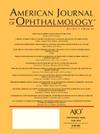多灶性脉络膜炎合并全葡萄膜炎和点状内脉络膜炎的证据和基于共识的成像指南-葡萄膜炎的多模态成像(MUV)工作组报告5。
IF 4.1
1区 医学
Q1 OPHTHALMOLOGY
引用次数: 0
摘要
目的为非感染性多灶性脉络膜炎和全葡萄膜炎(MFCPU)和点状内脉络膜炎(PIC)的多模态成像应用制定影像学和基于共识的指南。设计共识协议由文献审查和专家委员会使用名义小组技术(NGT)指导。方法专家委员会采用定时结构化名义组技术(NGT),就MFCPU和PIC的特定疾病特征、活性生物标志物和并发症达成基于共识的建议。本文回顾了非感染性活动性和非活动性MFCPU和PIC的代表性病例,包括彩色眼底照片(CFP)、光学相干断层扫描(OCT)、眼底荧光素血管造影(FFA)、OCT血管造影(OCTA)、吲哚菁血管造影(ICGA)和眼底自身荧光图像(FAF)。这些建议是由整个工作组投票通过的。结果专家一致认为,CFP可以很好地表征MFCPU和PIC病变。OCT是检测活动性病变的首选方法。FAF和OCT监测疾病复发均有效。晚期ICGA在FAF和CFP上看不到病变的复发性疾病中最有价值。虽然OCTA和ICGA可以成功地识别病变和并发症,如脉络膜新生血管,但在这两种模式下,没有发现可靠的成像生物标志物来区分活动性和非活动性病变。结论将影像学表现,特别是OCT,纳入MFCPU和PIC的葡萄膜炎命名标准化(SUN)分类标准,可以更准确地评估疾病活动性。这些基于共识的指南为MFCPU和PIC并发症的诊断、监测和识别选择最佳成像方式提供了框架。本文章由计算机程序翻译,如有差异,请以英文原文为准。
Evidence and Consensus-Based Imaging Guidelines in Multifocal Choroiditis With Panuveitis and Punctate Inner Choroiditis—Multimodal Imaging in Uveitis (MUV) Taskforce Report 5
PURPOSE
To develop imaging and consensus-based guidelines on the application of multimodal imaging in noninfectious multifocal choroiditis and panuveitis (MFCPU) and punctate inner choroiditis (PIC).
DESIGN
Consensus agreement guided by the review of literature and an expert committee using nominal group technique (NGT).
METHODS
An expert committee applied a timed structured nominal group technique (NGT) to achieve consensus-based recommendations on specific disease characteristics, biomarkers of activity, and complications for MFCPU and PIC. Representative cases with noninfectious active and inactive MFCPU and PIC with color fundus photographs (CFP), optical coherence tomography (OCT), fundus fluorescein angiography (FFA), OCT angiography (OCTA), indocyanine angiography (ICGA), and fundus autofluorescence images (FAF) were reviewed. These recommendations were voted upon by the entire task force.
RESULTS
The experts agreed that lesions of MFCPU and PIC can be well characterized using CFP. OCT is the preferred modality for detecting active lesions. Both FAF and OCT are effective for monitoring disease recurrence. Late-phase ICGA is most valuable in recurrent disease when the lesions are not visible on FAF and CFP. While OCTA and ICGA can successfully identify lesions and complications such as choroidal neovascularization, no imaging biomarkers were found to reliably distinguish between active and inactive lesions on these two modalities.
CONCLUSIONS
Incorporating imaging findings, particularly OCT, into the Standardization of Uveitis Nomenclature (SUN) classification criteria for MFCPU and PIC enables more precise assessment of disease activity. These consensus-based guidelines provide a framework for selecting optimal imaging modalities for diagnosis, monitoring and identification of complications of MFCPU and PIC.
求助全文
通过发布文献求助,成功后即可免费获取论文全文。
去求助
来源期刊
CiteScore
9.20
自引率
7.10%
发文量
406
审稿时长
36 days
期刊介绍:
The American Journal of Ophthalmology is a peer-reviewed, scientific publication that welcomes the submission of original, previously unpublished manuscripts directed to ophthalmologists and visual science specialists describing clinical investigations, clinical observations, and clinically relevant laboratory investigations. Published monthly since 1884, the full text of the American Journal of Ophthalmology and supplementary material are also presented online at www.AJO.com and on ScienceDirect.
The American Journal of Ophthalmology publishes Full-Length Articles, Perspectives, Editorials, Correspondences, Books Reports and Announcements. Brief Reports and Case Reports are no longer published. We recommend submitting Brief Reports and Case Reports to our companion publication, the American Journal of Ophthalmology Case Reports.
Manuscripts are accepted with the understanding that they have not been and will not be published elsewhere substantially in any format, and that there are no ethical problems with the content or data collection. Authors may be requested to produce the data upon which the manuscript is based and to answer expeditiously any questions about the manuscript or its authors.

 求助内容:
求助内容: 应助结果提醒方式:
应助结果提醒方式:


